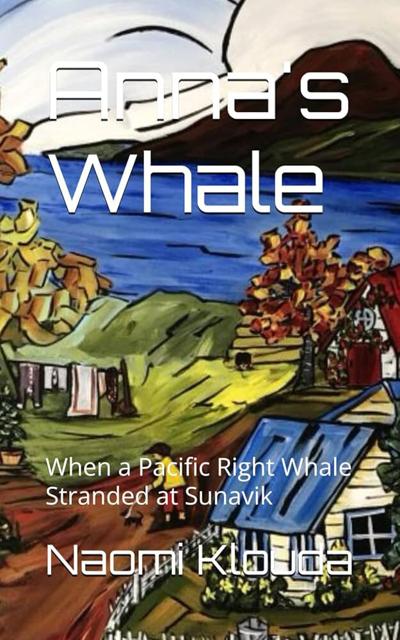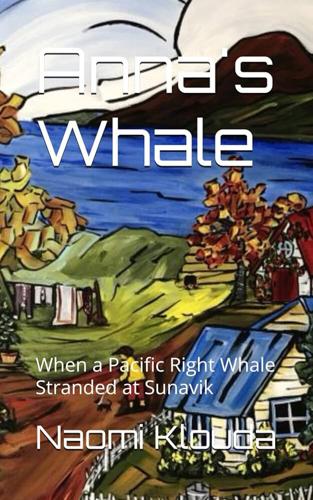‘"Something will change now,” 12 year old Anna’s grandmother Matrona tells her in the opening pages of Naomi Klouda’s debut novel “Anna’s Whale.” A North Pacific right whale has washed ashore at the fictional village of Sunavik, not a creature known to inhabit the nearby seas. “You’ll see,” she says when her granddaughter points out that it’s simply a dead whale. “Make one thing different and it sets off another.”
Change is coming in this brief but engrossing and ultimately delightful young adult novel. Change for Sunavik, a Yup’ik village in Alaska’s southwest, for the adults in Anna’s life, and for Anna herself, who makes the whale her focus during the transitional summer between sixth grade and her teens.
The book opens with Anna discovering the whale lying on the beach. As government employees are being called in to determine the reason for its sudden appearance, Anna takes it upon herself to be the whale’s protector. Especially after she discovers that it yet lives and appears to be carrying a calf.
What follows is a story not just about efforts at comforting the whale and hopefully returning it to the sea, but of people from vastly different cultures needing to bridge the divides between themselves to achieve a common goal. And, as is true in any such case, some make greater efforts than others. The tensions and breakthroughs that can happen in such a process form the true heart of the novel for which the whale, trapped on its side in the sand, provides the axis.
Now based in Homer, Klouda is a longtime Alaska journalist who has written for Bethel’s Tundra Drums newspaper, the Anchorage Times, the Kodiak Daily Mirror, and the Homer Tribune, and who also researches glaciers. She knows her way around Alaska, and sets her story in one of its remote regions where few Alaskans, much less anyone from further afield, are likely to intrude.
Until the arrival of the whale. This brings a series of government scientists into town, employees of both Fish & Wildlife and NOAA, along with an anthropologist who tags along. Anna, a precocious child unwilling to be excluded from a drama she has assertively placed herself in the middle of, pilots her way through the assortment of officials, finding allies while doing her best to assist the whale.
In this endeavor she is helped to varying degrees by two cousins of the same age. Sadie is only willing to go so far in risking the wrath of the white adults in charge, while Sam, initially interested only in pestering the other two, ultimately proves willing to lend a hand.
Overseeing all three is the cousins’ grandmother, Matrona, who is caught in her own tragedies and struggles, yet maintains a brave face true to her character. Widowed, she has been left as surrogate mother to Sadie, whose own mother has left her behind, and is the full-time caregiver to Anna, abandoned by both her Native mother and white father, who have divorced and gone in entirely different directions.
Sunavik, meanwhile, faces its own challenges. Battered by climate change, its houses are tilting on their pilings. The seas have grown rougher in recent years, and with them so has subsistence. The graveyard, set near the shore, is being chewed away by erosion.
That Klouda is able to juggle all of these balls in a story running a mere 95 pages that can be read in a single sitting is impressive for a first time novelist. As is the depth of the characters she creates here.
One thing Klouda never does, and it goes a long ways towards lending the story authenticity, is establish a villain. The white government officials who flood into Sunavik to learn what brought the whale there and hopefully find a solution to its dilemma aren’t out of central casting. They simply respond to the situation in differing ways. Among them is Sargent Hatfield, their no-nonsense leader who remains aloof from the local population, Chloe Sandford, a NOAA biologist barely into her thirties who befriends Anna and Sadie, and the anthropologist, Teddy Lambert, who finds welcome and a room in Matrona’s home.
Also weaving their way into the tale are Mayor Alex, who tries his best to act as go-between, mostly with success, and Anna’s parents, Selma and Thomas Crowley. Selma has left for Anchorage, where she found herself on the streets before landing in the Alaska Psychiatric Institute, while Thomas, a conservationist working for private nonprofits, long ago departed the village, where he felt his outsider status too strongly, leaving his family behind to pursue his career.
All of these players are brought together by the presence of the whale, which has made national news. They are also joined by the whale’s mate, heard offshore calling to its partner, although in practice, right whales are not monogamous. A bit of a miss, but somewhat forgivable for the sake of the story.
Reunions and understandings across divides are the underlying themes of the book, and Klouda, who has reported extensively on Alaska Native issues, presumably understands the sensitivities of telling a story that involves so many Native characters and their interactions with the outside world.
One thing that’s hard to avoid considering while reading this book is the impact of recent events. It was written when there were NOAA scientists to address occurrences such as a whale trapped on a beach, and a time when the government was run by people who cared about the fate of Indigenous residents of a far-flung village. In the real world of today, this story simply could not be told.
The story remains worthy of telling, however, perhaps more so now than ever. It’s a story of hope and recovery. And while the ending is perhaps a bit pat, “Anna’s Whale” leaves readers with something to hold on to in these difficult times. Something worth hoping for and hopefully recovering.
David James is a freelance writer who lives in Fairbanks. He can be emailed at nobugsinak@gmail.com.













